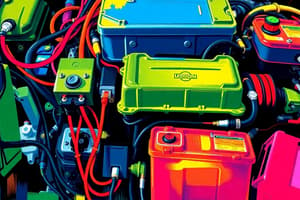Podcast
Questions and Answers
What is the main purpose of the magneto ignition system?
What is the main purpose of the magneto ignition system?
- Displaying information about the vehicle's performance
- Generating low voltage for engine operation
- Generating high voltage to ignite the air-fuel mixture in the engine's cylinders (correct)
- Controlling the vehicle's speed
Which component is responsible for inducing current in the coil in the magneto ignition system?
Which component is responsible for inducing current in the coil in the magneto ignition system?
- Distributor
- Magneto (correct)
- Spark plugs
- Rotor
What is a key maintenance task for the panel board instruments described in the text?
What is a key maintenance task for the panel board instruments described in the text?
- Inspecting and replacing wiper blades
- Filling up the fuel tank
- Replacing air filters
- Calibrating instruments (correct)
Which electrical system controls ignition timing and spark generation using electronic components?
Which electrical system controls ignition timing and spark generation using electronic components?
What is an essential maintenance task for the magneto ignition system?
What is an essential maintenance task for the magneto ignition system?
Which component in the panel board instruments receives electrical signals from sensors?
Which component in the panel board instruments receives electrical signals from sensors?
What would most likely happen if the magneto ignition system components are worn out?
What would most likely happen if the magneto ignition system components are worn out?
Which component of the magneto ignition system rotates to induce current in the coil?
Which component of the magneto ignition system rotates to induce current in the coil?
What is a key function of the panel board instruments described in the text?
What is a key function of the panel board instruments described in the text?
Flashcards are hidden until you start studying
Study Notes
Electrical Systems in Automobiles
- The electrical system in an automobile provides power to various systems and devices in a vehicle, including starting the engine, powering lights, indicators, wipers, and other essential functions.
Components of Automotive Electrical Systems
- Battery: Provides electrical energy to start the engine and power electrical systems when the engine is off.
- Alternator: Converts mechanical energy from the engine into electrical energy to recharge the battery and power the vehicle's electrical systems.
- Starter Motor: Responsible for starting the engine by turning the crankshaft, located on the engine block, connected to the flywheel or flexplate.
- Wiring Harness: Connects electrical components and delivers power throughout the vehicle.
- Fuses and Relays: Protect electrical circuits from damage due to overloads and control the flow of electricity to various components.
Battery System
- Provides electrical energy to start the engine and operate electrical systems when the engine is off.
- Components: Positive and negative terminals, electrolyte, lead plates, casing, vent caps, internal cell connectors, etc.
- Operation: Chemical reactions between electrolyte and lead plates generate electrical energy.
- Maintenance: Regularly check terminals, clean corrosion, ensure proper electrolyte levels.
Lighting System
- Illuminates the road and surroundings for visibility and safety.
- Components: Headlights, taillights, brake lights, turn signals, fog lights, interior lights, etc.
- Operation: Lights are powered by the vehicle's electrical system and controlled by switches and relays.
- Maintenance: Regularly check bulbs, replace faulty bulbs, inspect wiring for damage.
Indicators, Horn, and Wipers
- Indicators signal intended direction changes, horn alerts other drivers, and wipers clear windshield for visibility.
- Components: Turn signal indicators, horn assembly, wiper blades, wiper motor, etc.
- Operation: Controlled by switches that send electrical signals to activate the respective components.
- Maintenance: Check and replace faulty switches, inspect wiper blades for wear, ensure horn functionality.
Panel Board Instruments
- Display vital information about the vehicle's performance and status.
- Components: Speedometer, tachometer, fuel gauge, temperature gauge, warning lights, etc.
- Operation: Receive electrical signals from sensors and display relevant information to the driver.
- Maintenance: Calibration of instruments, replacement of faulty sensors, check wiring connections.
Magneto Ignition System
- Generates high voltage to ignite the air-fuel mixture in the engine's cylinders.
- Components: Magneto (magnet and coil assembly), ignition coil, distributor, spark plugs, points (contact breaker), condenser, rotor, cap.
- Operation: Magnet rotation induces current in the coil, producing high voltage for spark plugs.
- Maintenance: Regular inspection and replacement of worn-out components, checking and setting spark plug gaps.
Electronic Ignition System
- Controls ignition timing and spark generation using electronic components.
Studying That Suits You
Use AI to generate personalized quizzes and flashcards to suit your learning preferences.




